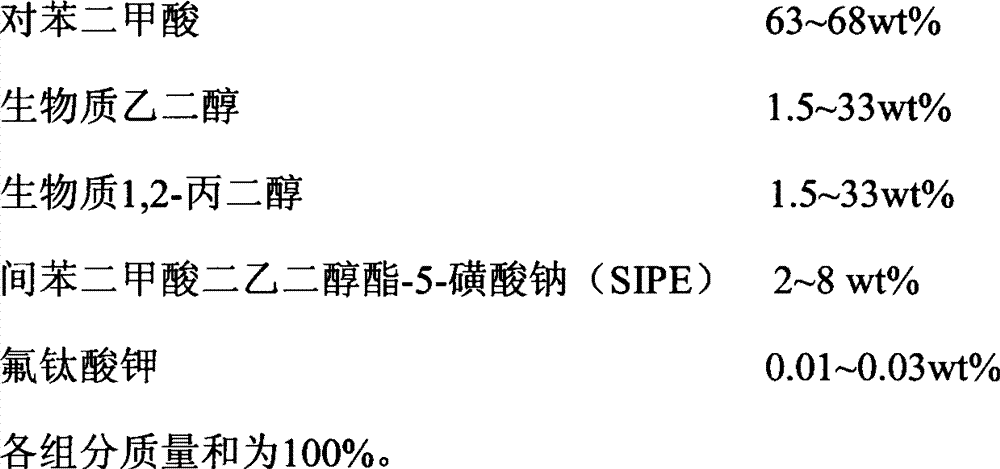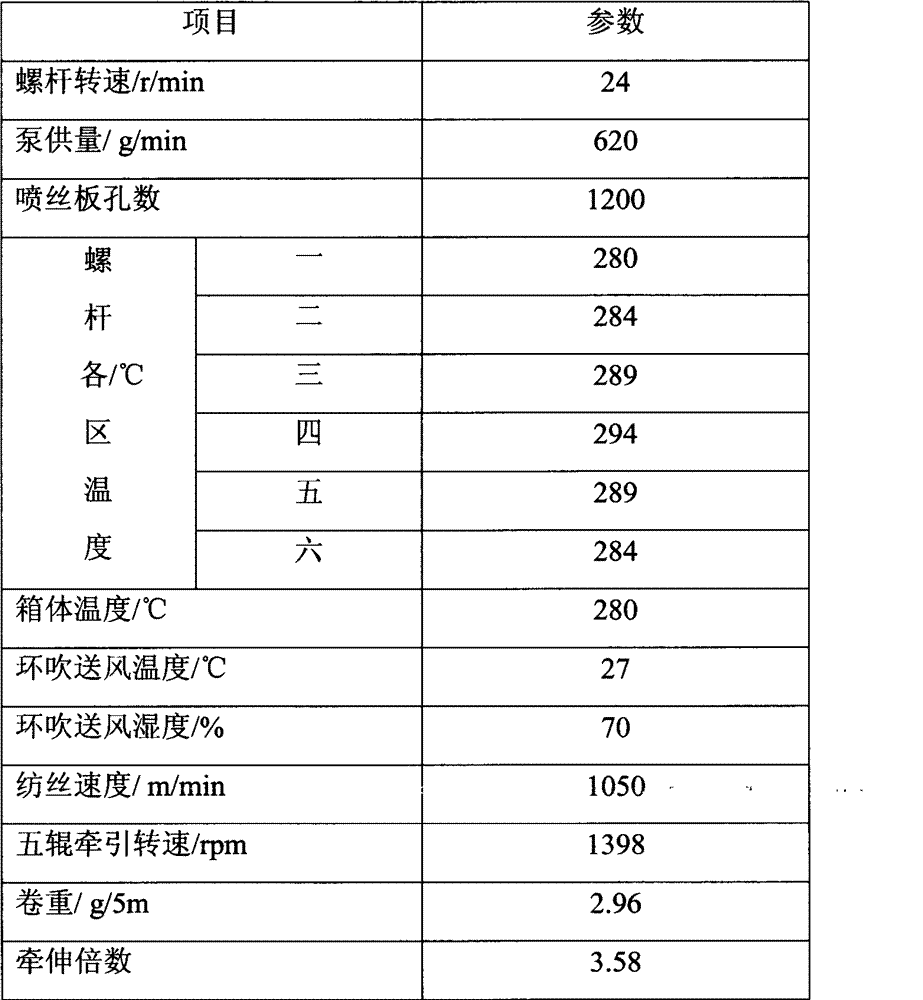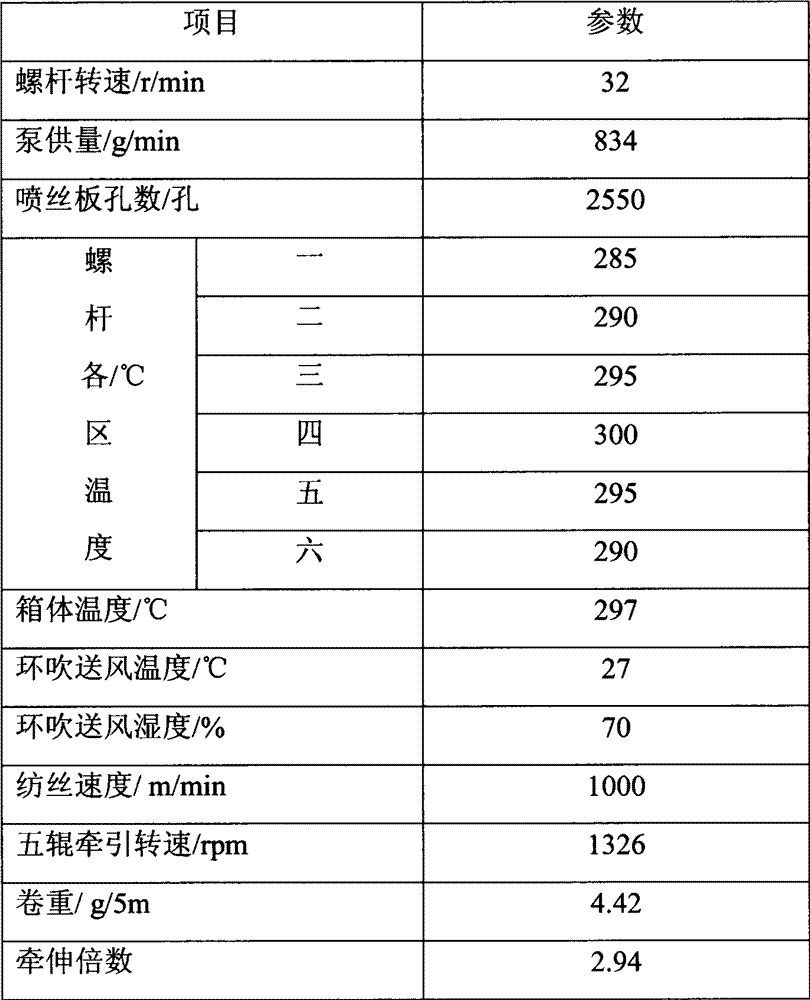Normal-pressure boiling dyeable biomass polyester fiber and preparation method thereof
A polyester fiber and biomass technology, applied in the field of biomass polyester fiber and its preparation, can solve the problems that biomass fiber cannot achieve normal pressure boiling dyeing characteristics, cannot be continuously produced, and has low production efficiency, so as to promote sustainable development. Development, cost saving, good resilience
- Summary
- Abstract
- Description
- Claims
- Application Information
AI Technical Summary
Problems solved by technology
Method used
Image
Examples
Embodiment 1
[0023] Configure 66wt% terephthalic acid, 28.48wt% biomass ethylene glycol, 1.5wt% biomass 1,2-propanediol, put them into the reactor, increase the pressure, and perform the esterification reaction at a temperature of 225°C and a pressure of 0.4MPa. After cooling, 4wt% of diethylene glycol isophthalate-5-sodium sulfonate (SIPE) and 0.02wt% of potassium fluorotitanate as a catalyst were added for heating and vacuum polycondensation to obtain biomass polyester chips. Completed in batch production facility. The prepared biomass polyester chips are dried, spun on the LHV431 spinning machine, and drafted and spun on the LHV903 combined drafting machine. After drying, spinning, winding, forming, bundling, drawing, crimping, After cutting, the biomass polyester fiber is obtained, and the main control production process parameters are shown in Table 1.
[0024] The control dyeing test is: PET fiber prepared with the same spinning and drawing equipment using conventional production techn...
Embodiment 2
[0029] Dispose 64wt% terephthalic acid, 1.5wt% biomass ethylene glycol, and 32.47wt% biomass 1,2-propanediol, put them into the reactor, increase the pressure, and perform the esterification reaction at a temperature of 220°C and a pressure of 0.6MPa. Add diethylene glycol isophthalate-5-sodium sulfonate (SIPE) 2wt% and catalyst potassium fluorotitanate 0.03wt% to perform heating vacuum polycondensation reaction to obtain biomass polyester chips. The whole reaction is carried out in a batch production unit In the process, the prepared biomass polyester chips are dried, spun on the LHV431 spinning machine, and drafted and spun on the LHV903 combined drafting machine. After drying, spinning, winding, forming, bundling, drawing, After crimping and cutting, the biomass polyester fiber is obtained. The main control production process parameters are shown in Table 2.
[0030] Table 2 The production process parameters of a normal pressure boiling-dyeing biomass polyester fiber
[0031] ...
Embodiment 3
[0035] Prepare 65% by weight of terephthalic acid, 26.4% by weight of biomass ethylene glycol, and 5.58% by weight of biomass 1,2-propanediol, add them to the reactor, increase the pressure, and carry out the esterification reaction at a temperature of 230°C and a pressure of 0.6MPa. Add 3wt% of diethylene glycol isophthalate-5-sodium sulfonate (SIPE) and 0.02wt% of the catalyst potassium fluorotitanate for heating and vacuum polycondensation to obtain biomass polyester chips. The whole reaction is carried out in a batch production unit In the process, the prepared biomass polyester chips are dried, spun on the LHV431 spinning machine, and drafted and spun on the LHV903 combined drafting machine. After drying, spinning, winding, forming, bundling, drawing, After crimping and cutting, the biomass polyester fiber is obtained. The main control production process parameters are shown in Table 3.
[0036] The control dyeing test is: PET fiber prepared with the same spinning and drawin...
PUM
| Property | Measurement | Unit |
|---|---|---|
| Melting point | aaaaa | aaaaa |
| Fiber length | aaaaa | aaaaa |
| Fiber denier | aaaaa | aaaaa |
Abstract
Description
Claims
Application Information
 Login to View More
Login to View More - R&D
- Intellectual Property
- Life Sciences
- Materials
- Tech Scout
- Unparalleled Data Quality
- Higher Quality Content
- 60% Fewer Hallucinations
Browse by: Latest US Patents, China's latest patents, Technical Efficacy Thesaurus, Application Domain, Technology Topic, Popular Technical Reports.
© 2025 PatSnap. All rights reserved.Legal|Privacy policy|Modern Slavery Act Transparency Statement|Sitemap|About US| Contact US: help@patsnap.com



